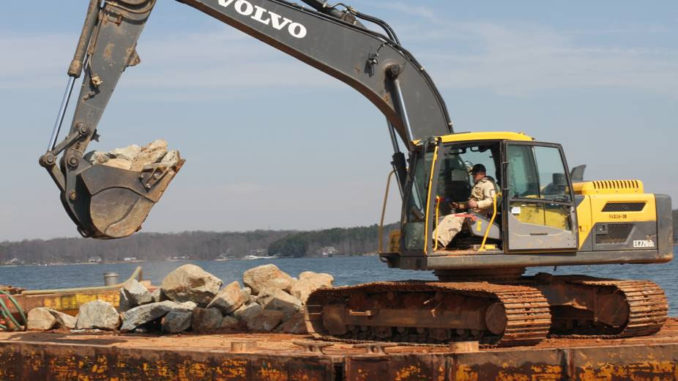
N.C. Wildlife Federation drops rocks off barges to create fish habitat
Artificial reefs long have been deployed in coastal waters to enhance habitat for fish. They’re made of sunken ships, concrete pipes and old bridge pilings. Now that same concept is being applied to Lake Norman near Charlotte with the creation of rock reefs in the 32,510-acre reservoir.
Initiated by the N.C. Wildlife Federation, hundreds of tons of rocks have been dumped from barges to build six reefs over the past three years. Shaped like elongated pyramids, the reefs run about 80 feet long, 30 feet wide and four to 12 feet high, according to Tim Gestwicki of Charlotte, the federation’s chief executive officer.
Gestwicki said the boulders stacked in the reefs almost immediately draw little fish to forage on algae and hide in the crevices. That in turn draws gamefish such as spotted bass and black crappie to prey on the baitfish.
“You establish structure, and you’re going to get game fish affinity,” he said. “These sites provide a congregation of fish of various sizes.”
The most recent two reefs, costing between $26,000 and $32,000, were completed in March in the mouth of Little Creek in CatawbaCounty and off Brawley School Road in Iredell County. Two other reefs are north of the NC 150 bridge; two more are near the Brawley School Road peninsula.
Gestwicki said the reefs aren’t marked with buoys but by GPS coordinates. They’re listed on the Website of the Lake Norman Wildlife Conservationists, a federation member chapter. Go to www.lakenormanwildlife.org/images/Rock%20Reefs.jpg.
To pay for the reefs, the federation applied for grants from Duke Energy’s Habitat Enhancement Program, a cooperative initiative by Duke, the N.C. Wildlife Resources Commission and the S.C. Department of Natural Resources. Fees charged for building docks and marinas in lakes on the Catawba/Wateree river system and from contributions from Duke support a fund for such projects.
Gestwicki said Lake Norman was chosen for the reefs because of its lack of submerged trees and its large angler population. All the trees on the lake bottom were removed before Norman was flooded in 1963.
“There’s really not a lot of woody debris in Lake Norman,” he said.
Many lakeside property owners have created their own fish habitat by dropping Christmas trees into the water. That technique may work for a while, but the trees rot away and underwater currents can wash them away. By contrast, the rock reefs will remain intact indefinitely.
Gestwicki said sites for the reefs were chosen after consulting Duke Energy fishery biologists, federation biologists and the Lake Norman Marine Commission.
The reefs present no hazard to navigation as they are set deep enough so the tops of the rock piles reach no higher than 27 feet below the surface.
He said the federation plans to apply for future additional reefs for Lake Norman, though there are no plans to seek reefs in other Catawba River lakes. He said as far as he knew Norman has the only man-made rock reefs in the state.




Be the first to comment